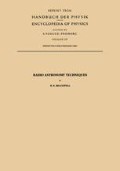Abstract
The basic observation in radio astronomy is the determination of the strength of ratio waves coming from different directions over an area of sky. We may be concerned with a large part of the sky, as when making a galactic survey, or only a small part, as when studying the emission from discrete objects or sets of objects. We may also be concerned with the spectrum and the polarization and time dependence of strength, spectrum and polarization. In the case of those solar disturbances known as outbursts we have to deal with sources whose strength, spectrum, polarization, position and presumably size all change greatly in the course of minutes, but more usually the position is simpler and we begin with the measurement of strength as a function of position on the sky. This includes galactic surveys and the determination of position, size, and brightness distribution of discrete sources at a single frequency. All other types of measurement then reduce, at least in principle, to repetition on other frequencies, at other times, and with differently polarized aerials.
Access this chapter
Tax calculation will be finalised at checkout
Purchases are for personal use only
Preview
Unable to display preview. Download preview PDF.
References
All these assumption can be expected to break down in practice in special cases.
There is also an official movement under way to name this unit the jansky per steradian in honor of Karl Jansky who first studied radio waves of extraterrestrial origin.
J.L. Pawsey and R.N. Bracewell: Radio Astronomy. Oxford 1955.
G. Doetsch: Theorie und Anwendung der Laplace-Transformation. Berlin 1937.
R.N. Bracewell and J. A. Roberts: Austral. J. Phys. 7, 615 (1954).
Our proof applies strictly only to plane apertures, but we know from experience that the directivity of a highly directional array cannot be improved much by rearranging its elements within the same overall dimensions. In any particular case the existence of the cut-off could be verified, and the value of s c determined, by taking the Fourier transform of the radiation pattern. Low-gain apertures which are comparable with, or less than, a wavelength in extent, can be harmonized with the present treatment by considering only that part of the aperture distribution which does not generate evanescent fields. In fact strictly speaking the function E*E* should be evaluated in all cases only after removal from E of those components which do not radiate. By not doing so one ignores an effective extension of the aperture distribution to a distance of about A/2. To this extent, an aperture distribution never really cuts off sharply.
Rights and permissions
Copyright information
© 1962 Springer-Verlag Berlin Heidelberg
About this chapter
Cite this chapter
Bracewell, R.N. (1962). Theory of aerial smoothing. In: Radio Astronomy Techniques. Reprint from Handbuch der Physik / Encyclopedia of Physics. Springer, Berlin, Heidelberg. https://doi.org/10.1007/978-3-662-39512-7_4
Download citation
DOI: https://doi.org/10.1007/978-3-662-39512-7_4
Publisher Name: Springer, Berlin, Heidelberg
Print ISBN: 978-3-662-38653-8
Online ISBN: 978-3-662-39512-7
eBook Packages: Springer Book Archive

